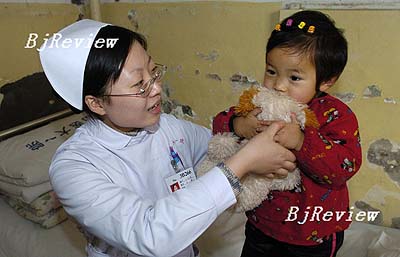|

Every 60 seconds two children are born in China with a handicap. It's an alarming fact, but one that young adults across the country who hope to have children face every day.
At a conference on the prevention of birth defects in Chengdu of Sichuan Province in September, Vice Minister of the National Population and Family Planning Commission Jiang Fan revealed this inconvenient truth, supported by shocking statistics.
According to Jiang's speech, defects among Chinese infants rose from 104.9 per 10,000 births in 2001 to 145.5 in 2006, an increase of nearly 40 percent. He added that while each year 200,000 to 300,000 babies are born with visible deformities, the total number of new infants afflicted with defects is in fact between 800,000 and 1.2 million, as invisible deformities often show up later in life. This means that birth deformities affect up to 6 percent of new births each year and handicapped babies have been born to over 30 million families, or one tenth of all Chinese families.
Of all the infants born with handicaps, only 20 to 30 percent have been corrected. About 40 percent suffer lifelong deformities, while the remaining 30 to 40 percent die shortly after birth.
Jiang went on to say that the high occurrence of birth defects has imposed heavy financial burdens on the country's economy. He quoted figures showing that tens of billions of yuan was spent on the treatment of babies with birth defects while the indirect economic expense of caring for these children amounts to hundreds of billions of yuan.
The World Health Organization (WHO) estimates that 3-5 percent of children worldwide are born with birth defects. Cleft palettes, natural tube defects, abnormal numbers of fingers or toes, congenital heart disease and water on the brain are the top five birth defects among Chinese babies. Experts said hereditary diseases, viral infections, environmental pollution, unhealthy lifestyles and poor nutrition were the main known reasons.
The National Population and Family Planning Commission issued a circular on birth defects prevention in November, which required local family planning agencies to offer special pregnancy counseling to the five most vulnerable groups of people: couples from families with hereditary diseases or a history of giving birth to handicapped babies, couples who have given birth to low IQ or handicapped babies, pregnant women who have experienced a miscarriage or given birth to a dead baby, pregnant women over 35 years old and couples who work in harsh conditions.
Lessons of Shanxi
China's largest coal-producing region Shanxi Province has had the highest rate of birth defects in the country since national surveys began in 1996. Shanxi's birth defects rate in 1996 stood at 189.86 per 10,000 births, doubling the national average of that year. Of the 13 counties in Shanxi whose rate has surpassed 4 percent, Heshun County stood out, registering a staggering 9 percent defect rate between 1998 and 2001. Over 30 types of defects plagued new births during this period, covering almost all categories of birth defects monitored by WHO.
An Huanxiao, Director of Shanxi's family planning agency, was quoted by The Beijing News saying that birth defect rates were related to environmental pollution. Analyzing the geographical characteristics of birth defect cases in Shanxi, An said residents in its northern mountainous regions registered substantially higher levels of birth defects compared with those in the region's southern flatlands. "Surveys demonstrate that birth defects in the province's eight large coal-mining regions are far above the national average," he said.
The research also showed that levels of birth defects vary widely between city and rural residents in Shanxi. Congenital defects generally occur more in regions with a backward economy, poor basic education and higher levels of disease.
Earlier studies on birth defects by local researchers revealed several factors that make the situation particularly bad in Shanxi. Besides suffering the effects of polluted air, food and water, there are also high levels of marriages between people who are related, low numbers of prenatal checkups due to difficult transportation conditions and a lack of knowledge about pregnancy health due to illiteracy.
The Shanxi Provincial Government has taken measures to reverse the trend of climbing birth defect rates since 2001, by providing nutrition supplements, especially folic acid and iodine, to birth-age and pregnant women, popularizing knowledge about pregnancy health and improving access to pregnancy checkups. These measures have come into effect as Taiyuan, capital city of Shanxi, has seen its birth defect rate slump to 1.18 percent in 2007, down by 20 percent since 2004, said a report in the Shanxi Evening News in November.
Urban life takes a toll
By studying the correlation between women's exposure to ozone and
| 